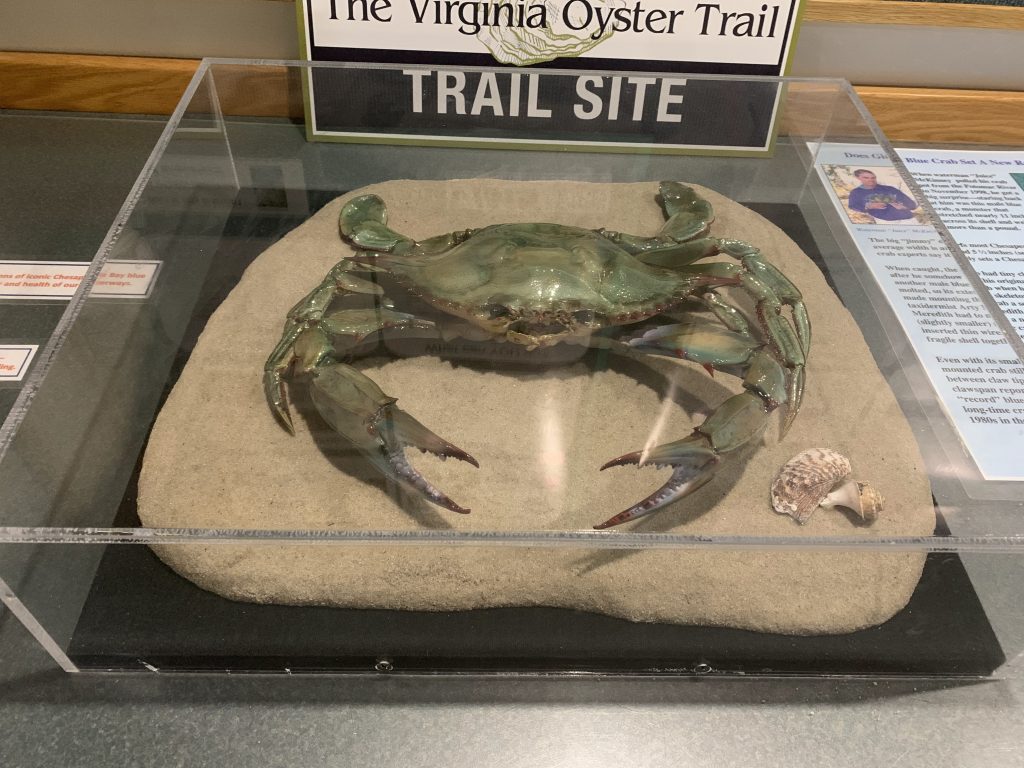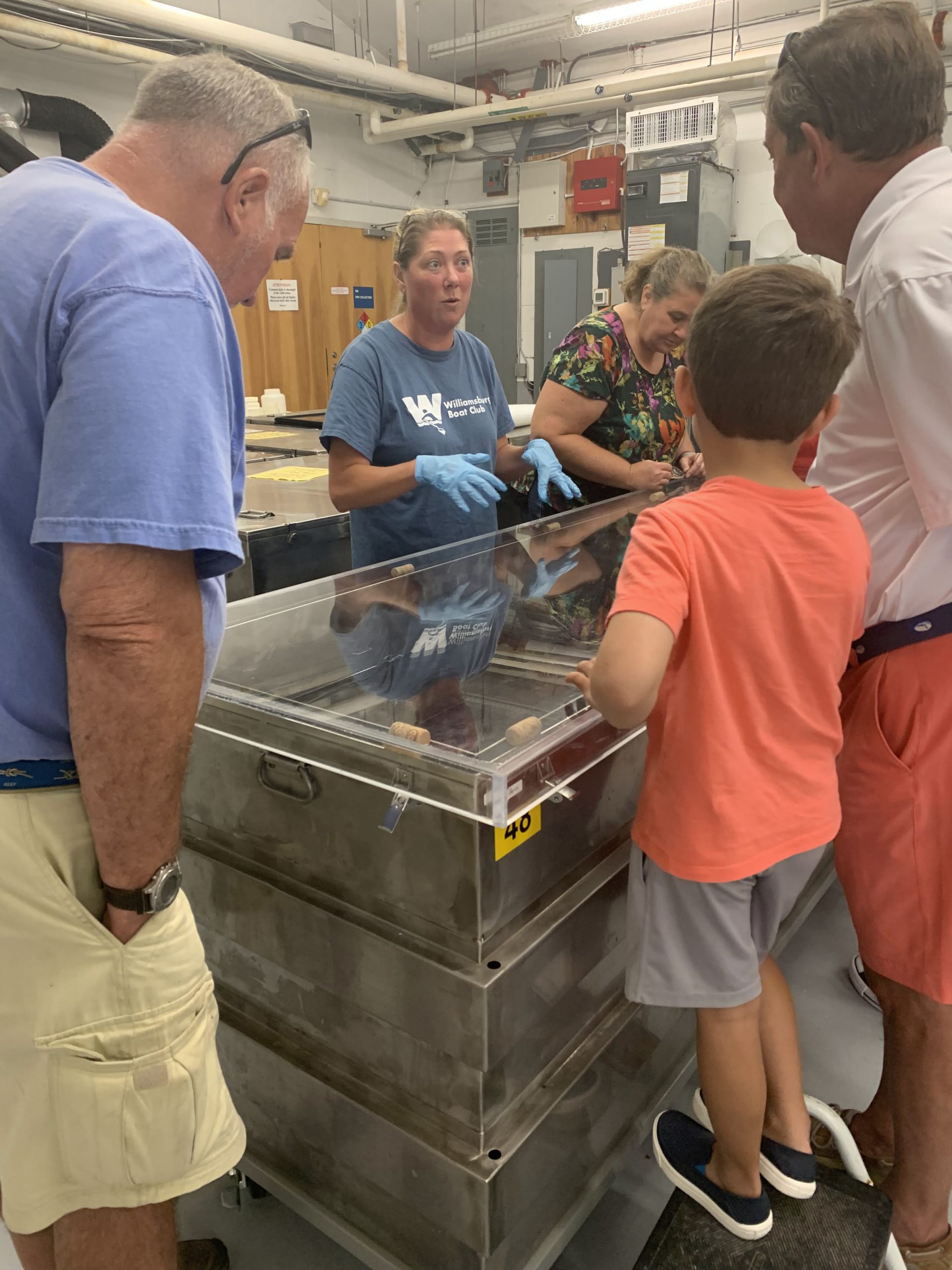After being sidelined the past two years due to the pandemic, the Virginia Institute of Marine Science returned to hosting tours of its facilities this month, giving people a behind-the-scenes peek at what goes on at the Gloucester Point facility.
The free tours are held on Fridays from 10-11:30 a.m. throughout August. Although free, reservations are required to participate. Details can be found at www.vims.edu/public/publictours/index.php.
The tour requires a lot of walking so it is best to wear proper attire and accommodations may be available for those with limited mobility. The tours are geared to adults and children ages 9 and up.
The tour starts at Watermen’s Hall, where everyone gathers in the lobby and walks to the auditorium to officially meet the guides for the day. This past Friday’s tour was guided by volunteers Lyon Ewell and Helmut Walter. They begin the tour by explaining the history of VIMS and the mission behind their work.
“We are one of the leading science museums in the world, funded primarily off taxpayer dollars and donations,” Ewell said. “We focus our research on the Chesapeake Bay and the coastal area. We are not a regulatory agency. We work together with fishermen to help preserve the Chesapeake Bay and to also ensure that they can continue to make a living.” He talked about how VIMS began.
“VIMS started in 1940 across the York River by Dr. Donald W. Davis. In 1950, it was moved to its present location and has since become a 40-acre campus. We also have a graduate program for William and Mary students.” They also discussed the other locations that they have in the area.
“We also have another campus on the Eastern Shore of the ocean called the Kauffman Aquaculture Center. We primarily have our non-native species at that location.” After they discussed how VIMS began and what they do there, they gathered everyone into golf carts and drove to the Acuff Center for Aquaculture. This facility is where scientists do much of their hands-on research and it is also a place where oysters are raised.
The tour guides walk their guests through the process the oysters go through in the facility, mainly, the spawning phase, the free-swimming larval phase and the setting process.
Guides first show their guests the Broodstock Conditioning room and what that process entails. They explained that Broodstock Conditioning is a process where the conditioning systems in the facility will give the oysters what they need to encourage the oyster’s gamete development. This system controls the water temperature inside the tanks and the oysters also get a certain amount of algae feed concentration in their tanks. Certain conditions can either allow or set back spawning of the adult oysters.
Ewell and Walter guided the group to another part of the facility to talk about the next step, which is spawning. They explained this step in great detail as well, that in the spawning process they combine the male and female gametes, which in turn results in the production of fertilized eggs. Those eggs will then eventually become larvae. There are two different ways they can cause the oysters to spawn—strip spawning or induced spawning.
Ewell and Walter led the group to where they would have the larvae in the tanks and they explained the larval phase, which can last between two to three weeks. The larvae are constantly monitored during this phase under the lens of a microscope. They also ensure that the aeration systems work properly and that the larvae receive constant water changes, creating a good environment for the larval cultures. The guides explained this last step of the process is the setting phase, showing where this step happens at the hatchery.
They said that the setting phase is the process that the larvae go through when they metamorphose into tiny oysters. The oysters go through this stage in the hatchery for approximately two to three weeks and they are then moved to the outdoor nursery system. The guides said they will donate some of their oysters in this facility to oyster farmers. Then they drove the entire group in golf carts to the next building called the Nunnally Ichthyology Collection.
The guides introduced the group to Sarah Muffelman, a marine scientist at VIMS. Muffelman, who is also a Mathews High School graduate, went into further detail about the collection of fish at the Nunnally Ichthyology Collection. She also showed the group a variety of different types of fish in the collection, one particular fish and its impact on the environment in the Chesapeake Bay.
“We are currently having a problem where we have non-native species attacking our native species,” she said. “This fish is called the Northern snakehead. It can be mistaken for our native Bowfish, but one way to tell the difference is that the Bowfish has a spot. This fish eats our native species and they also can walk on land and end up in other places. If you catch one, it is best that you kill it.”
Muffelman then took the group to see a sturgeon and a shark in their collection that is preserved with ethanol. After the tour of the Nunnally Ichthyology Collection, the group returned to Watermen’s Hall, with a view over the York River to end the tour. Following the tour, the group had the opportunity to explore the library and gift shop there on their own.
In addition to the tours, VIMS is bringing back its After Hours Lectures and has Discovery Labs that the public can also attend.


